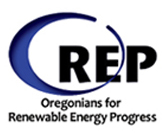OREP PUC UM 1505 Comments, 2/11/11
before the public utiity commission
of Oregon
UM 1505
In the Matter of )
)
PUBLIC UTILITY COMMISSION )
OF OREGON ) COMMENTS OF
) OREGONIANS FOR
Solar Photovoltaic Program ) RENEWABLE ENERGY POLICY
Oregonians for Renewable Energy Policy (OREP) appreciates the opportunity to contribute comments and recommendations on the Solar Photovoltaic Pilot Programs. Our comments address recommendations for adjustment to the April 1, 2011 enrollment period as well as longer-term recommendations. In brief, we support more data collection for the April 1, 2011 enrollment process and transition to an enrollment process that provides more equitable access to applicants.
1. Recommendations for the April 1, 2011 Enrollment Period
The solar industry has seen many changes in the last few months with the sunset of the tax credit programs on the horizon and the launch of the solar photovoltaic pilot programs. The industry needs stability. Therefore, we recommend that the April 1 enrollment period proceed on schedule. However, there is broad consensus that the pilot programs needs to collect more data on the size and characteristics of the applicant pool, beyond the small group of successful applicants in each enrollment period. It would seem feasible for the utilities to collect information from applicants as to the size and geographic location of the systems they seek to apply for after the full capacity is reserved, rather than simply shutting down the website immediately after the last kilowatt of capacity is reserved. OREP is in full support of the Comments of the Oregon Department of Energy and the Energy Trust of Oregon in this regard.
2. Support for changing the enrollment process as soon as possible
We have heard complaints from many applicants about the online, first-come –first-served enrollment process. Complaints of gaming the system with computer programming and complaints about inequity in speed of Internet service indicate that the first-in-time system must be changed. It is vital to the success of the pilot programs that they are perceived by the public as being fair. We support changing the participant selection process for the <10 kW and 10 – 100 kW categories beginning October 1, 2011. A lottery seems to offer one viable solution to this problem.
3. Recommendations for October 2011 and beyond Resource Value
HB 3039 and 3690 created new charges for the Public Utility Commission, some of which remain to be acted upon. Among these are establishing the resource value of energy produced under the pilot programs. ORS 757.360(4) defines “resource value” as the estimated value to an electric company of the electricity delivered from a solar photovoltaic energy system associated with:
(a) The avoided cost of energy, including avoided fuel price volatility, minus the costs of firming and shaping the electricity generated from the facility;
(b) Avoided distribution and transmission cost; and
(c) The renewable energy certificates established under ORS 469A.130
In order to report on the cost of the programs and their impact on rates, it is necessary to include the benefits of the program in the calculation. We recommend that the PUC take immediate steps to establish the full value of the avoided cost of energy, the value of the avoided distribution and transmission cost and the value of the renewable energy certificates. Without all of these statutory elements being accounted for, we will not have the accurate resource value as defined by the statute
Assistance and Advice on Financial Support
ORS 757.365(11) provides: “The commission shall advise and assist the owners and operators of qualifying systems in identifying and using grants, incentive moneys, federal funding and other sources of noninvestment financial support for the construction and operation of qualifying systems.” We feel that this statutory mandate has been overlooked so far. We recommend that the commission begin to collect and provide information on financial support via a public website. Part of the Legislature’s charge to the commission is to consider regulatory policies designed to increase the use of solar photovoltaic energy systems and make them for affordable. There is a lack of a central information source on the solar incentive program, especially in the area of financing. To the extent that the commission can reduce installed costs to participants by providing this information, ratepayer impact can be reduced.
The commission might also be advised that the Oregon Solar Pilot Project FIT-style incentive, being independent of the system owner’s tax status or liability, works in powerful conjunction with the current federal treasury grant taken in lieu of the federal tax credit to allow new classes of participants to install solar. However, the federal treasury grant is currently applicable only to business entities and is due to expire at the end of 2011. It would be highly appropriate for the PUC to endorse extension of the federal treasury grant to individuals as well as businesses and to make it permanent.
Promoting the Development of the solar industry in Oregon
In addition to considering regulatory policies designed to make solar photovoltaic systems more affordable, the commission is required to consider policies that promote the development of the solar industry in Oregon. (See fn 1, supra) We recommend that the commission start acquiring data, not only on the installed capacity and installed cost of systems, but also on the development of the solar industry. This data should include the number and size of solar companies that installed projects, the geographical distribution of work, the number of person hours worked per quarter and the source of equipment that is installed. Without data of this sort, the commission will not be able to report to the Legislature on the impact of its policies on the development of the solar industry.
Survey Questions
We recommend that a process be created whereby stakeholders can have input into the questions the utilities are asking in their surveys of pilot program participants, so that the most useful information can be collected. For example, one question that should be asked in one of the follow-up surveys is the participant’s average annual electricity consumption prior to the installation of the solar photovoltaic systems and the average annual consumption following the installation of the system. Information of this sort would be useful in the formulation of future policies.
Liability Insurance Requirement
We continue to recommend that the insurance requirement be removed and a hold harmless agreement or pooled policy be substituted in its place. Every effort should be made to simplify participation in the pilot program and reduce soft costs to applicants. To increase the use of solar photovoltaic systems and reduce the cost of incentive programs to utility customers, it is important to reduce expenses wherever possible. Insurance is one area that, over the fifteen-year life of the contract, adds roughly $1500 to $3000 to the cost of a system; in the case of a 2 kW system, roughly $1.50 per watt.
Meter Charge
We recommend that the additional $10 monthly meter charge for the second meter be eliminated. PGE’s electric bills state: “The Basic Charge supports fixed costs such as meter reading, equipment, maintenance and billing necessary to serve customers, regardless of the amount of energy used. You pay the basic charge even if no electricity is used. It is a charge for having service available.” From the utility perspective, there would seem to be duplication in the charge for meter reading, billing and “having service available.” Over the life of the pilot program contract, $10 per month amounts to $1800. This is a significant expense for a small system, another seemingly small cost that makes solar photovoltaic energy systems less affordable and indirectly increases the cost to utility customers.
The impact of FERC rulings
The October 21, 2010 and January 20, 2011 FERC decisions in the California PUC case remove the central obstacle to a real feed-in tariff in Oregon. Unless appealed in federal court, these opinions create an avenue for the commission to set feed-in tariff rates for renewable energy fed into the grid. Revising the pilot programs to eliminate the perverse incentive to consume and doing away with limitation that systems produce less energy than the customer-generator consumes would benefit the programs. The net-metering system could be eliminated, leading to a simpler system, and making it possible to compare a feed-in tariff to the pre-existing system of tax credits and incentives. We would also recommend an intelligent incentive being incorporated into the program, (after the British model) whereby residential customers are paid a small additional incentive for producing energy in excess of what they consume, thereby promoting energy conservation as well as renewable generation.
In order for Oregon to utilize the FERC system, it might be necessary to have a statutory change in which the state would mandate generation of a specified amount of energy from specified renewable resources. We recommend that the commission, at its earliest opportunity, request an opinion from the Department of Justice on whether statutory changes would be needed in order for Oregon to reap the benefit of FERC’s recent rulings.
What’s in a name?
Lastly, we would gently point out that the pilot programs have three names: PGE has the “Solar Payment Option.” Pacific Power has the “Oregon Solar Incentive Program.” Idaho Power has the “Oregon Solar Photovoltaic Pilot Program.” All are good names, but in the interests of simplicity and consistency, we would encourage our good friends at all three utilities to endeavor to use one label in the future for their program. Consumers like simplicity and consistency.
DATED this 11th day of February 2011.
Oregonians for Renewable Energy Policy (OREP)
/s/ Mark E. Pengilly /s/ Kathleen A. Newman
OREP Representatives


